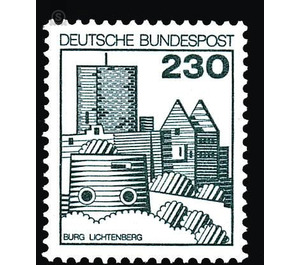Postage stamp: castles and palaces - Germany / Federal Republic of Germany 1978 - 230 Pfennig
Theme: Architecture
| Country | Germany / Federal Republic of Germany |
| Issue Date | 1978 |
| Face Value | 230.00 |
| Color | green |
| Perforation | K 14 |
| Printing Type | Lithography |
| Stamp Type | Postage stamp |
| Item Type | Stamp |
| Chronological Issue Number | 886 |
| Chronological Chapter | GER-BRD |
| SID | 983078 |
| In 52 Wishlists | |
Supplementary value to the 1976/77 introduced series of rolling stamps »castles and palaces« The 230 Pf value appears at the same time and the same motif as the inscription Deutsche Bundespost Berlin. Lichtenberg in the Palatinate, one of the largest castles in Germany, located on a high ridge, shows impressive buildings and ruins. The Counts of Veldenz founded the fortification (Unterburg) as patrons of the monastery Remigiusberg on his land probably already in the 12th century. In 1214 King Frederick II ordered the demolition, but the construction was continued. Around 1270 put Heinrich von Geroldseck, who had married the Veldenzer Erbtochter and founded the line Veldenz-Geroldseck, the upper castle (keep with Südpalas). The Eastern Palas was built around 1325, the West Palas around 1400. Probably after 1300 lower and upper castle were connected by walls. 1444 inherited the dukes of the Pfalz-Zweibrücken Lichtenberg, which became the administrative center and was until 1758 the seat of a higher office. In 1529, Ulrich Zwingli spent the night here with his companion on the round trip to the Marburg religious talk. When the house Zweibrücken-Kleeburg the kings of Sweden (1654-1718), the castle was under the Swedish throne. 1799 devastated by carelessness a fire the plant. From 1816 to 1834, the Principality of Lichtenberg belonged to the Duchy of Saxe-Coburg-Gotha. Since 1894 security work took place. (Extract from texts by the German Castle Association e.V. Braubach - Dr. W. Avenarius)


